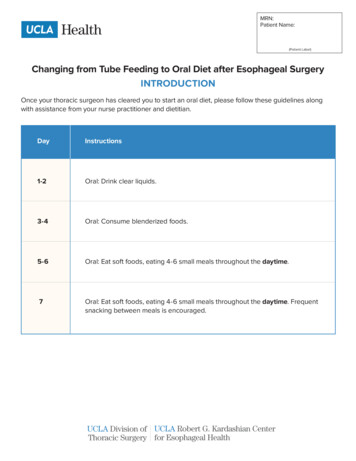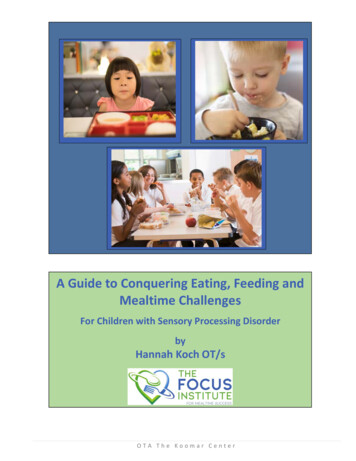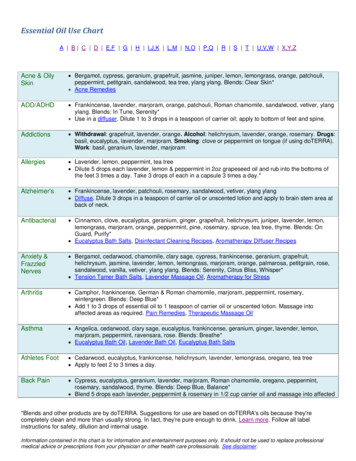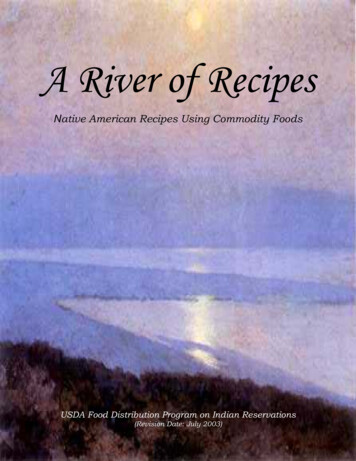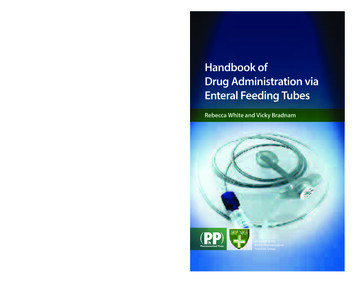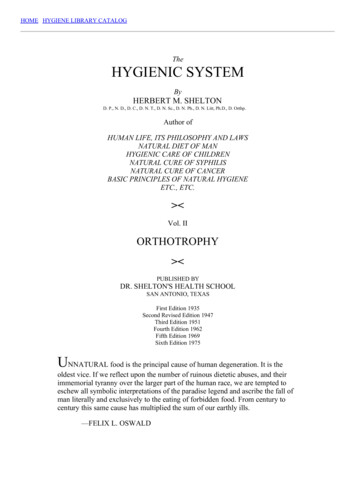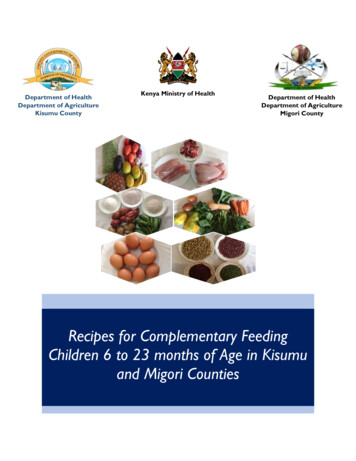
Transcription
Department of HealthDepartment of AgricultureKisumu CountyKenya Ministry of HealthDepartment of HealthDepartment of AgricultureMigori CountyRecipes for Complementary FeedingChildren 6 to 23 months of Age in Kisumuand Migori Counties
ContentsAbbreviations . iiAcknowledgements . iiiForward .1Introduction.2The Food Groups .3Table I: Feeding Recommendations Based on Age .5Modification of Foods to Suit the Child .5PORRIDGES .6DAIRY .9PULSES, LEGUMES AND NUTS . 10FRUITS . 11ANIMAL SOURCE FOODS – FLESH FOODS . 12EGGS. 16VITAMIN A RICH FRUITS AND VEGETABLES. 18HEALTHY SNACKS . 20Meal Plan . 22Table II: Sample Meal Plan . 23List of Contributors . 24i
AbbreviationsFAOFood and Agriculture Organization of the United NationsIYCNInfant and Young Child NutritionMCSPMaternal and Child Survival ProgramOFSPOrange-Fleshed Sweet PotatoTIPsTrials of Improved PracticesUSAIDUnited States Agency for International Developmentii
AcknowledgementsWe would like to thank the various institutions and individuals who contributed to the successful developmentof the complementary feeding recipes:Department of Health, Nutrition Unit, Kisumu and Migori countiesDepartment of Agriculture, Home Economics Section, Kisumu and Migori countiesKenya Ministry of Health, Nutrition and Dietetics UnitCommunities of Kisumu and Migori countiesThe Maternal and Child Survival ProgramThis recipe booklet is made possible by the generous support of the American people through the United StatesAgency for International Development (USAID) under the terms of the Cooperative Agreement AID-OAA-A14-00028. The contents are the responsibility of the Maternal and Child Survival Program and do not necessarilyreflect the views of USAID or the United States Government.iii
ForwardIn Kenya, only 22 % of children are fed in accordance with the three recommended infant and young childfeeding practices.1 According to a survey conducted in Kisumu county, 43% of children 6-23 months are fedaccording to the recommended infant and young child nutrition (IYCN) feeding practices.2 Through the Maternaland Child Survival Program (MCSP), Trials for Improved Practices (TIPS) was undergone in Kisumu and Migoricounty on complementary feeding practices and findings revealed knowledge gaps among mothers reporting onchallenges on specific foods, which deterred them from feeding these foods to their children.3 Cultural beliefs,practices, and misconceptions were also evident and influenced complementary feeding.This contributed to the need of development of food recipes to promote good IYCN.About the Recipe BookletThis booklet is organized to provide information and guidance for caregivers (someone including a familymember or a paid helper who takes care of the child) on how to prepare the meals for children 6-23 months ofage with locally available foods in Kisumu and Migori countries, Kenya.Overall ObjectiveTo improve complementary feeding practices of children aged 6-23 months in Kisumu and Migori counties,Kenya.Specific Objectives1. To help mothers and caregivers understand the seven food groups and identify healthy meals and snacksfor their young children.2. To provide guidance on methods of food preparation and modification of locally available foods.Kenya National Bureau of statistics, Ministry of Health/Kenya, National AIDS Control Council/Kenya, Kenya Medical Research Institute,National Council for Population and Development/Kenya and ICF International, 2015. Kenya Demographic and Health Survey 2014.Rockville, MD, USA: Kenya National Bureau of Statistics, Ministry of Health/Kenya National AIDS Control Council/Kenya, Kenya MedicalResearch Institute, National Council for Population and Development/Kenya and ICF International.2 UNICEF and Kenya Ministry of Health. 2017. Knowledge, Attitudes and Practices Survey: Status of Maternal Infant and Young Child Nutrition inKisumu county. Kisumu, Kenya: UNICEF.3The Maternal and Child Survival Program (MCSP). 2017. Complementary Feeding Practices: Using Trial for Improved Practice (TIPs) to ImproveComplementary Feeding in Migori and Kisumu, Kenya. Kisumu, Kenya: MCSP.11
IntroductionThe World Health Organization defines complementary feeding as the process of giving other foods inaddition to breastmilk after six completed months. Breastmilk alone is no longer sufficient to meet thenutritional requirements of infants at this age and therefore other foods are needed.The Kenyan Maternal Infant and Young Child Nutrition Policy Guidelines strives to promote, protect andsupport exclusive breastfeeding for the first 6 months.4 It also highlights the need to ensure timely, appropriateadequate and safe complementary feeding for children 6 to 23 months using locally available foods and continuedbreastfeeding up to 2 years and beyond. The Guide to complementary feeding5 enables users developappropriate recipes based on locally available foods.Factors to Consider for Complementary Feeding Age of the child – at the various stages in growth for children 6-23 months, the nutrient requirementsincrease. Locally available and accessible foods. Cultural beliefs and traditional practices affecting food choices for children. Responsive feeding and sensory stimulation. Health status of the child. The mother’s/caregivers’ knowledge, attitude and practices on optimal complementary feeding.Criteria for Complementary FeedingFoods should meet the basic criteria for complementary feeding which includes, FATVAH.Frequency: The meal frequency should be based on age appropriate recommendations.Amount: The amount of food given to the young child at each meal should be adequate for the age and providesufficient energy, protein and micronutrients to meet the growing child’s nutritional needs.Texture: The food consistency should be age appropriate and adapted to the child’s requirements and abilities.Variety: A child should eat a variety of foods that provide different nutrients to meet the child’s nutritional needs.Active feeding: Encouraging and support a child to eat enough food at each meal.Hygiene: Foods should be hygienically prepared, stored and fed with clean hands using clean utensils – bowls,cups, and spoons.What is Food?Food is anything we eat or drink that gives the body energy, protect, maintain and repair the tissues.45Ministry of Health. 2013. National Maternal, Infant and Young Child Nutrition Policy Guidelines. Nairobi, Kenya: Ministry of Health.Ministry of Health. 2017. A Guide to Complementary feeding 6-23months. Draft. Nairobi, Kenya: Ministry of Health.2
The Food GroupsChildren need a variety of foods to get all the nutrients that the body needs in the right proportions. Food canbe classified in different ways, depending on their nutrient contribution to the diet. According to the Food andAgriculture Organization of the United Nations (FAO) 2016 guidelines,6 feeding ofchildren 6 to 23 months should focus on including foods from at least four of theseven food groups as below:1. Grains, roots, tubers and plantainsThis group of foods forms the largest part of our meals in terms of bulk orvolume. They supply most of the energy and in Kenya; maize is the most commonstaple food. Examples include maize, millet, sorghum, rice, wheat, amaranth, oats,bread, pasta, spaghetti, sweet potatoes, Irish potatoes, cassava, arrowroots, yams,and plantain.Photo Credit: Constance Gathi/MCSP2. Legumes, nuts and seedsLegumes (dried beans, lentils, peas, green grams), nuts (groundnuts, cashew nuts,Bambara nuts, macadamia) and seeds (pumpkin seeds, amaranth seeds, simsim, sunflower seeds) are good sources of protein, energy, essential fats, fiber andmicronutrients.3. DairyPhoto Credit: Constance Gathi/MCSPDairy foods are rich sources of proteins, vitamins and minerals. Examples includemilk from cows, goats, buffalo, sheep, and camels.4. Flesh foodsFlesh foods – such as meat, fish, poultry, and insects – are excellent sources ofnutrients, including protein, fat and micronutrients.Liver is a very rich source of protein, iron, zinc, vitamin B complex vitamins andvitamin A.Oily fish are rich sources of vitamin D, omega 3, and 6 fatty acids, which areimportant for the development of the brain.Photo Credit: Brenda Ahoya/MCSPVitamin A, Iron and zinc are especially important for child growth anddevelopment.Children who lack vitamin A, iron and zinc do not grow well and may grow up lessintelligent than children who receive adequate amounts.Photo Credit: Constance Gathi/MCSP6FAO and FHI 360. 2016. Minimum Dietary Diversity for Women: A Guide for Measurement. Rome: FAO.3
5. EggsEggs are a very good source of inexpensive high quality proteins. They alsocontain vitamins, minerals, and essential fatty acids. Examples are eggs fromboth domesticated poultry and wild birds.6. Vitamin A rich fruits and vegetablesVitamin A rich fruits and vegetables typically contain beta-carotene, which isimportant for good vision, normal growth and development and the control andprevention of infections. Examples include ripe mango, passion fruit, apricot,pawpaw, deep yellow flesh and orange-fleshed sweet potatoes, dark green leafyvegetables, carrots, and pumpkins.Photo Credit: Brenda Ahoya/MCSP7. Other fruits and vegetablesThis group includes vegetables not counted above as dark green leafyvegetables or as other vitamin A-rich vegetables. Diets rich in fruits andvegetables are associated with positive health outcomes. Examples includefresh peas, snow peas, snap peas or green beans, cucumber, and tomato.Photo Credit: Constance Gathi/MCSPPhoto Credit: Constance Gathi/MCSP4
Table I: Feeding Recommendations Based on AgeAge6 monthsNumber of Meals & Snacks2 meals per dayContinue breastfeeding ondemandAmount per MealDuring the first two weeks, 2 tablespoonsper mealDuring the 3rd and 4th week, 3 tablespoonsper meal7-8 months3 mealsContinue breastfeeding1/2 cup per meal9-11 months3 meals1 snackContinue breastfeeding3/4 cup per meal12-24 months3 meals2 snacksContinue breastfeeding1 cup per mealModification of Foods to Suit the ChildChildren from 6 months of age onward can eat foods from all the food groups. However, these foods have to bemodified depending on the age of the child. There are various ways of modifying foods for children as listedbelow: Mashing e.g. beans, sweet potatoes, butter nut and fruitsShredding of flesh foods e.g. beef, fish, poultryPounding e.g. omenaGrating e.g. carrots, beetroots, boiled eggsVertical slicing, dicing and mincingGrinding e.g. ground nutsGrinding of Nuts. Photo Credit: Brenda Ahoya/MCSP5
Specific modifications of foods should be made for children of different age groups. These include: At 6 months: Mashing At 7-8 months: Mashing, pounding, grating, shredding, grinding, mincing At 9-11 months: Mashing, mincing, grating, shredding, slicing, dicing, finger foods such as whole fruits e.g.banana, mango At 12-23 months: Finger foods, dicing, slicing, mincing, whole foodsWhat is a Recipe?A recipe is a set of instructions for making or preparing different nutritious dishes.Below are examples of recipes for some foods that are problematic in preparation or which caregivers havechallenges in modifications for younger children.PORRIDGESFrom the TIPs findings, all children consume porridge. However, the porridge is either made with many floursmixed together, is not fermented (thus iron is not available), and the consistency is also very thin. The followingsteps can be used to make porridge that is thick enough and does not fall/drip off the spoon (to give moreenergy to the child), and ensure that iron is made available.Germinating Grain for PorridgeUse wimbi or sorghum or any other grain.Process of Germinating Grain Sort the grain Soak for 24 hours Drain and put in a clean jute bag or osinde* grass or use banana leaves Store in a dark warm place and leave for 2- 3 days until the grains germinate Sun dry the germinated grain then grind into flourPorridge from Germinated Grain FlourIngredients 1 cup flour from germinated grain 2 cups waterMethod Pour 1 cup of water in a sufuria and bring to boil Put the flour in a bowl, add one cup of water to the flour in the bowl and stir to make a paste Slowly add the paste to the boiling water as you stir6
Continue to stir the mixture until it thickens Let it cook under low heat for 10 minutes Serve amount according to age of the child Enrich with any of the food items as indicated below (under enriching porridge)**Makes one cup of porridgeBenefits of Germination Sprouting reduces anti-nutritional compounds in raw legumes Sprouts are rich in digestible energy, bioavailable vitamins, minerals, amino acids, proteins, andphytochemicals Germinated cereals reduces anti- nutrients e.g. phytic acid which inhibit absorption of some mineralslike iron and zinc It also increases the vitamin (B and C) and mineral content of the food It Improves digestibility and nutritional quality of the proteins and essential amino acids Examples of foods that can be germinated include cereals like millet sorghum, dried beans and lentilsFermenting Flour for PorridgeA number of cereals are good sources of iron. However, the iron is bound and therefore not available. Theprocess of fermentation makes the iron available. It also has additional benefits as: It makes the foods easier to digest and the nutrients easier to assimilate It also help retains beneficial enzymes, vitamins, and other nutrients that are usually destroyed by foodprocessing Fermented foods are excellent sources of probiotics (good bacteria) which help improve digestion andhelp in detoxification They are also rich in Vitamin K and Vitamin B complex, which help protect against disease and enhanceimmune function Fermentation reduces the anti-nutritional factors, enhances flavor, color and textureTo ferment flour for porridge follow the following steps:Use wimbi, sorghum, or any other available grain.Ingredients ¾ cups warm water 1 cup ground millet flourPorridge paste prepared forfermentation. Photo Credit:Brenda Ahoya/MCSPMethod Put the flour in a plastic container or earthen pot or stainless steel container7
Pour the warm water into the flour and stir to make a smooth paste Leave for one day to fermentPreparation of Porridge from Fermented FlourIngredients 1 cup fermented flour paste 2¾ cups waterMethod Pour 1 cup of water in a sufuria and bring to boil Add the prepared paste slowly and continue stirring until it thickens Simmer for ten minutes Serve amount according to age of the child Enrich with any of the food items as indicated below**Makes 2¼ cup of porridgeCooked fermented porridge of the correct thickness. Photo Credit:Brenda Ahoya/MCSPBenefits of Fermentation Fermentation makes the foods easier to digest and the nutrients easier to assimilate It also helps retains beneficial enzymes, vitamins, and other nutrients that are usually destroyed by foodprocessing Fermented foods are excellent sources of probiotics (good bacteria), which help improve digestion andhelp in detoxification They are also rich in Vitamin K and Vitamin B complex, which help protect against disease and enhanceimmune function Fermentation reduces the anti-nutritional factors, enhances flavor, color and texture8
Enriching PorridgePorridge can be enriched with any of the following: avocado, ripe banana, soya paste, groundnut paste, simsimpaste, or oil.Note: Ensure you only use one of the above.Avocado Enriched PorridgeIngredients 2/3 cup porridge made from geminated or fermented flour 1/3 slice of avocado 1/2 a piece of a medium sized orange (used to prevent the avocadofrom browning)Method Cut the 1/3 slice of avocado into small pieces in a bowl and mash Remove any seeds from the orange and squeeze the orange into themashed Avocado and mix to form a smooth paste Add the avocado/orange paste into the 2/3 cup of porridge and stiruntil fully mixedPorridge enriched with avocado.Photo Credit: Brenda Ahoya/MCSPDAIRYChildren can be given the fresh milk to drink. However, ensure that themilk has either been boiled or heat-treated through pasteurization.Fermented milk and yoghurt are also good for children since they help torestore the ‘good bacteria’. These can be given either as a snack or with ameal.Preparation of Fermented MilkIngredients 1 liter of fresh milkMethodFermented milk served with OFSP andpumpkin leaves (mashed). Photo Credit: Sieve the milkBrenda Ahoya/MCSP Boil Let it cool Put in a fermentation container {guard or stainless steel} enamel containers or melamine containers. Leave for 2-3 days to ferment Serve as a snack or with orange-fleshed sweet potato (OFSP) or ugali.9
PULSES, LEGUMES AND NUTSPulses and legumes are important source of protein. There are several ways to prepare them for your child.They can either be cooked whole or sprouted e.g. green grams. After preparation of the pulses and legumes, itcan be fed completely to an older child or mashed for a younger child.Preparation of Bean StewIngredients 1 kilogram dried beans 1 large size onion, chopped 4 tomatoes, chopped Salt to taste 2 carrots, diced 3 tablespoons of cooking oil 2.5 litres of waterMethod Sort the beansWash and soak for 12 hours or overnightDiscard the soaking waterBoil the soaked beans in 2.5 liters of water for 45 minutes to 1 hour or until softDrain the beans and keep the stockPut oil in a sufuria and heat then add onions, and fry until softAdd tomatoes and cook until tenderAdd carrots, stir and simmer for 2 minutesAdd cooked beans and stir wellAdd the stock, cover with a lid and leave to simmer for 5 minutes until the soup is thickAdd salt to taste and stir then serveServe with rice, ugali, green bananas, or sweet potato.Sprouting LegumesSprouting is the process through which plants grow from a seed. Green-grams or beans or cowpeas seeds orpigeon peas can be sprouted.Benefits of Sprouting It increases the vitamin, mineral and protein content of foods It helps in the digestion of food It cuts down on cooking time.10
Process of Sprouting BeansIngredients 1 kilogram beans 3 litres of waterMethod Soak the beans for 12 hours Drain water Keep the seeds in the dark until sprouting begins The sprouts are ready to cook Cook as bean stewPreparation of Soya StewMethod Sort out the soya bean Put enough quantity of water in a sufuria (1part of soya to 3 partsof water) Heat the water to boiling point Drop in the soya beans little at a time maintaining the same boilingpoint Boil for 30-45 minutes Remove from the fire Put the boiled beans in cold water immediately to stop boiling Stew as beansSoya stew served with vegetablesand rice. .Photo Credit: BrendaAhoya/MCSPServe with rice, chapati, or bananas.Note: For making flour, sundry the beans well and mill For soya milk, chunk and sauce, blend/mash the beans.FRUITSIt is important to ensure that children are fed fruits. Fruits will improve your baby’s appetite and growth. Fruitscontain vitamins and minerals important to the baby to help prevent and protect from illnesses, diseases and11
support immunity.7 In addition, children like the sweetness of the fruits. It is better to give whole fruits asopposed to making juice from the fruits. For younger children who are starting complementary feeding, fruitscan be mashed into a smooth paste and fed to the child.Examples of fruits include pawpaw, avocado, watermelon, bananas, mangoes, guavas, pears, apples, passion fruit,zambarao, plums, loquats, oranges or any other available fruit. Fruits can be given whole as finger foods ormashed based on the age of the child. Use fruits that are locally available and in season.One example is given of how to mash pawpaw for the child. This method can be repeated with other fruits forchildren being introduced to complementary foods.Mashed AvocadoIngredients 1/3 avocado 1/4 orangeMethod Wash the avocado and leave to dryPeel and cut into small piecesPut in a container and mash using a food masher or a wooden spoonRemove any seeds in the orangeSqueeze the juice from the orange onto the avocado and mix wellPut in a feeding cup or plateNote: 7-8 months, give mashed fruits 9-23 months, give whole fruits as finger foodsMashed avocado with orange. Photo Credit: Brenda Ahoya/MCSPANIMAL SOURCE FOODS – FLESH FOODSFlesh foods are excellent sources of nutrients including; protein, fat and micronutrients such as iron and zincthat will prevent anaemia and help the child grow well. Examples of flesh foods include meat, fish, poultry, birds,Justine Kavle, Sohair Mehanna, Gulsen Saleh, Mervat Foaud, Magda Ramzy, Doaa Hamed, Mohamed Hassan, Ghada Khan, and RaeGalloway. 2014. Examining Factors Associated with Stunting in Lower Egypt in Comparison to Upper Egypt. Bridging the Gap between CulturalBeliefs and Feasible Feeding Practices through Trials for Improved Practices. Cairo, Egypt: Maternal and Child Health Integrated Program.712
insects, liver and other organ meats. These flesh foods can be prepared as per the recipes described. The fleshfoods can be minced (any meat) or pounded (omena) or mashed (fresh fish) for younger children and shredded,or sliced for older children.Preparation of Beef StewIngredients 1/4 kilogram of beef 1 medium onion, chopped 2 medium tomatoes, chopped Salt to taste 1 table spoon of cooking oil 1 cup of waterMethod Wash the meat before slicing Cut the meat into small pieces Boil the meat until tenderBeef stew served with rice and vegetable. Shred the meatPhoto Credit: Brenda Ahoya/MCSP Put oil in sufuria and heat Add onions and fry until soft Add tomatoes stir and simmer for 2 minutes Add cooked meat and stir Add 1 cup of water and mix well Simmer for 5 minutes Add salt to tasteServe with spinach or amaranth leaves or pumpkin leaves with ugali, rice, or OFSP.Preparation of Chicken StewIngredients 1/4 kilogram of chicken 1 medium tomato, chopped 1 medium onion, chopped13
Salt to taste 1 cup of water 1 teaspoon of cooking oilMethod Wash the chicken Slice or cut into small pieces Boil until tender Put oil in sufuria and heat Fry the onion until soft Add tomatoes and simmer until tenderShredding chicken that is already cooked. PhotoCredit: Brenda Ahoya/MCSP Add cooked chicken Stir well then add water Cook under low heat for 5 minutes Add salt to tasteServe with spinach or amaranth leaves or pumpkin leaves with ugali, rice, or OFSP.Note: After cooking a full chicken for the family, the liver and heart should be given to the child since it is agood source of iron. Mash the liver or heart for the younger ones, and or cut into small cubes for the olderchild.Preparation of Fresh Fish StewIngredients Fresh, medium sized fish2 medium size tomatoes, chopped1 medium size onion, chopped1 table spoon of cooking oil2 cups of waterSalt to tasteMethod Remove scales, intestines, wash the mouth and gillsWash the whole fishCut into three piecesPut oil in a sufuria and heatFry the onions until softAdd tomatoes, simmer until softAdd water and bring to boilAdd fish and simmer for 20 minutes until it is well cookedAdd salt to taste14
Flake the fish and ensure there are no bones left in the fishServe with ugali or rice and vegetables.Preparation of Fresh Omena StewIngredients 1/2 kilogram fresh omena 1 large onion, chopped 2 medium size tomatoes, chopped 2 grated carrots 2 tablespoons of oil Salt to taste 2 cups of waterMethod Sort the omenaWash with cold waterHeat oil in a sufuriaAdd and fry the onions till soft, then add tomatoes andsimmer until softAdd 2 cups of water and bring to boilAdd omena and simmer for 20 minutesAdd carrots and continue to simmer for 2 minutesAdd salt to tasteOmena stew mashed for a younger child. Photo Credit:Brenda Ahoya/MCSPServe with ugali or rice or green bananas or OFSP andvegetables. For a child who is seven months, the cooked omena can then be pounded as shown in the picture.Preparation of Dried Omena StewIngredients 1/2 kilogram dried omena1 large onion, chopped2 medium tomatoes, chopped2 grated carrots15
2 tablespoons of oil Salt to taste 3 cups of waterMethod Sort the omena, wash with warm water and rinse with coldwater Bring to boil for 10 minutes and simmer for 5 minutes Drain the omena and keep the stock Heat oil on a sufuria Add the onions and fry until soft , add tomatoes then simmeruntil tender Add omena Add little water or stock and simmer for 2 minutes Add carrots and simmer for 2 minutes Add salt to tasteServe with ugali, rice, green bananas, or OFSP and vegetables.Dried omena stew being served. Photo Credit:Brenda Ahoya/MCSPEGGSEggs are a very good source of inexpensive high quality proteins. They also contain vitamins, minerals, andessential fatty acids. Eggs can be prepared in a variety of ways e.g. poaching, boiling and scrambled. Oncecooked, eggs can be mashed for younger children.Preparation of Poached EggsIngredients 3 Eggs 2 cups of water Salt to tasteMethod Bring a shallow sufuria of water (2 inches) to boil Add salt and stirPoached eggs. Photo Credit:Brenda Ahoya/MCSP Wash the eggs Break the eggs and slide them gently into the water Simmer for 3-5 minutes till the eggs have set Remove the eggs using a “mandazi” spoonServed with rice or ugali, and vegetable or any other staple food.16
Preparation of Scrambled EggIngredients 1 egg Salt (optional) 1 teaspoon oil Few leaves of dhania 1 small size tomato, chopped 1 small size onion, choppedMethodUgali with scrambled eggs and vegetables for an olderchild. Photo Credit: Brenda Ahoya/MCSP Wash the egg Break the egg and beat using a fork Heat the oil in a shallow sufuria on medium heat Pour the beaten egg and add all the other ingredients Stir using a wooden spoon as you cook under low heat for 5minutes Add salt to tasteServed with rice. ugali, or any other staple food and vegetable.Preparation of Groundnut SauceNuts provide both protein and fats. Fat is also an important source ofenergy.Ugali with scrambled eggs and vegetables mashedtogether for a younger child. Photo Credit: BrendaAhoya/MCSPIngredients 1 kilogram groundnuts Salt to tasteMethod Sort out the groundnuts and wash Roast the groundnuts in a sufuria Grind or blend to get the powder Add fermented milk or water to the powder and mix to makea pasteGroundnut sauce. Photo Credit: Brenda Ahoya/MCSP Put the mixture on fire, cook and continue stirring until thesauce is smooth Add salt to taste (optional)Served with sweet potatoes or green bananas or Irish potatoes or rice and vegetables.17
Preparation of ButternutIngredients 1 medium size butternut 2 cups of waterMethod Wash the butter nut Put in a sufuria and add water Cover with a tight fitting lid or banana leaves Boil for 15-20 minutes Peel the thinner layer and mash or give as a finger foodButternut boiled whole with skin being cut inslices. Photo Credit: Brenda Ahoya/MCSPServe with a groundnut sauce or fermented milk or beans and vegetables.VITAMIN A RICH FRUITS AND VEGETABLESSautéing is a quick method of cooking that requires only a very small amount of oil, fat or even water.Vegetables only require partial cooking before being consumed. Nutritional value of vegetables remainsparticularly high. No nutrients are being lost in discarded liquid.8Preparation of VegetablesCooking VegetablesThis is applicable for spider weed, black nightshade, sweet potato leaves,amaranthus, and cowpeas.Ingredients 2 bunches of tender spider weed 2 medium size tomatoes, cho
At 12-23 months: Finger foods, dicing, slicing, mincing, whole foods What is a Recipe? A recipe is a set of instructions for making or preparing different nutritious dishes. Below are examples of recipes for some foods that are problematic in preparation or which caregivers have challenges
